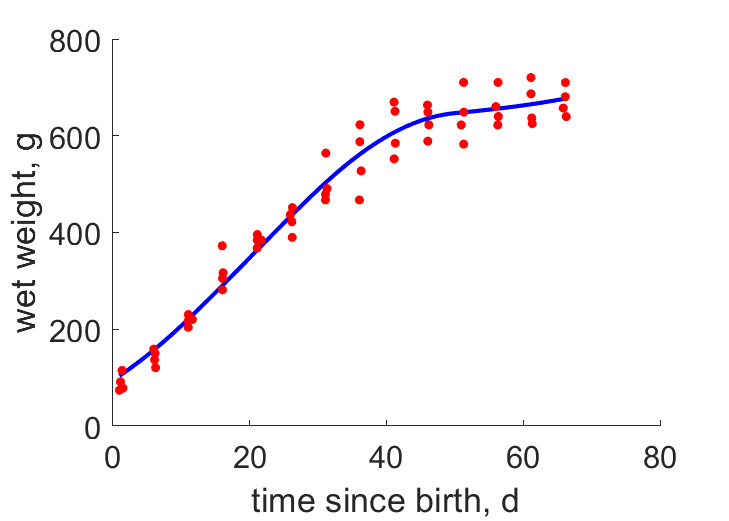Predictions & Data for this entry
| Model: std | climate: MB | migrate: | phylum: |
| COMPLETE = 2.5 | ecozone: MPSE | food: biCvf, biCi, biSi, biSv | class: |
| MRE = 0.054 | habitat: 0iMm, biMc | gender: Dg | order: |
| SMSE = 0.005 | embryo: Tnsfm | reprod: O | family: |
Zero-variate data
| Data | Observed | Predicted | (RE) | Unit | Description | Reference |
|---|---|---|---|---|---|---|
| ab | 32.7 | 34.9 | (0.06715) | d | age at birth | avibase |
| tx | 60 | 59.53 | (0.007821) | d | time since birth at fledging | avibase |
| tp | 180 | 158.5 | (0.1195) | d | time since birth at puberty | guess |
| tR | 2008 | 2008 | ( 0) | d | time since birth at 1st brood | guess |
| am | 1.168e+04 | 1.166e+04 | (0.002044) | d | life span | guess |
| Ww0 | 74.3 | 93.35 | (0.2563) | g | initital wet weight | avibase |
| Wwb | 70.75 | 65.52 | (0.07389) | g | wet weight at birth | Harr1970 |
| Wwi | 687 | 757.4 | (0.1025) | g | ultimate wet weight | avibase |
| Ri | 0.00274 | 0.002622 | (0.04281) | #/d | maximum reprod rate | avibase |
Uni- and bivariate data
| Data | Figure | Independent variable | Dependent variable | (RE) | Reference |
|---|---|---|---|---|---|
| tW |  | time since birth | wet weight | (0.06185) | Harr1970 |
Pseudo-data at Tref = 20°C
| Data | Generalised animal | Creagrus furcatus | Unit | Description |
|---|---|---|---|---|
| v | 0.02 | 0.03497 | cm/d | energy conductance |
| p_M | 18 | 556.4 | J/d.cm^3 | vol-spec som maint |
| k_J | 0.002 | 0.02314 | 1/d | maturity maint rate coefficient |
| k | 0.3 | 0.3051 | - | maintenance ratio |
| kap | 0.8 | 0.9246 | - | allocation fraction to soma |
| kap_G | 0.8 | 0.7985 | - | growth efficiency |
| kap_R | 0.95 | 0.95 | - | reproduction efficiency |
Discussion
- Long tp cannot be captured by std model
- mod_1: v is reduced
- mod_1: food availability is taken variable in tW data
- mod_2: Pseudo-data point k is used, rather than k_J; Data set tp and parameter t_R are added, the latter replacing clutch interval t_N. Postnatal T is based on PrinPres1991, see get_T_Aves. See further the revision page, theme puberty
Bibliography